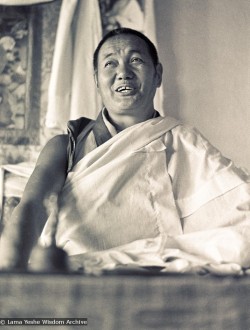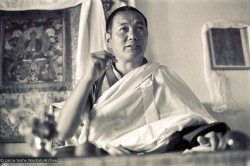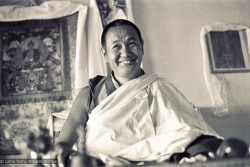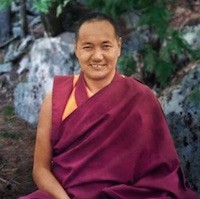
Actually, watching your internal world is much more interesting than watching a movie and certainly more worthwhile. Once you’ve seen a movie, you don’t want to see it again; you get bored the second time. But if you watch your mind with skillful wisdom you will never get bored. Every minute, there’s something new. Your mind is constantly moving. It’s a remarkable experience.
Every time your ego contacts an object, its interpretation leaves a different imprint on your consciousness. Those imprints react again and again. That’s what we call karma—cause and effect. The imprints are the cause; the reaction is the effect. That’s karma. Therefore we say that karma is very powerful. Why? Because the imprints left by previous ego activity are very powerful; extremely strong.
The energy force of ego bursts into your mind without permission. Even if you don’t want it to enter it forces its way in. If someone were to rush into your house without knocking you’d get really upset, wouldn’t you? “What’s going on? You didn’t even knock!” Even if your closest friend comes in without knocking you’re likely to object. So isn’t it silly that when the negative energy force of ego walks uninvited into your mind, instead of getting upset you say, “Welcome, ego. Please come in. How are you? Have a cup of tea. Would you like some chocolate?”
All we ever do is try to please our ego; it’s like we’re always paying homage to our ego, offering it tea, chocolate and prayers. We dedicate all our energy to our ego and what do we get in return? What does our ego offer us? Mental pollution. It brings such a foul, suffocating smell in our minds that there’s hardly room to breathe.
 So from now on, instead of welcoming your ego’s energy force, stand guard against it with mindfulness and wisdom, watching with penetrative attention for the first sign of its arrival. And when it comes, instead of greeting it warmly, “How are you, ego? Come right in,” examine it with a great big wisdom eye—a wisdom eye bigger than your head. Just watch it. When you give your ego the wisdom eye it disappears all by itself.
So from now on, instead of welcoming your ego’s energy force, stand guard against it with mindfulness and wisdom, watching with penetrative attention for the first sign of its arrival. And when it comes, instead of greeting it warmly, “How are you, ego? Come right in,” examine it with a great big wisdom eye—a wisdom eye bigger than your head. Just watch it. When you give your ego the wisdom eye it disappears all by itself.
Mental continuity
In your next meditation session, I would like you to check how your mind of today is related to the experiences of yesterday’s ego games. Check; observe. How are they linked? Similarly, check back to last week, last month, last year. Go all the way back through your life. Check with your big wisdom eye how your ego and attachment have functioned over the years; how you have identified things at different ages; how you have perceived different views, all of which have been projections of your own ego.
If your mind were not connected with last year’s ego, there’d be no reason for memories to keep coming back uncontrollably into your mind. Therefore, check how these experiences relate to the continuity of mind. Go back as far as your time in the womb. Forgetting previous experiences and clinging to the future is not realistic. Unless you have psychic power, you have no idea whether you’ll be alive next year or not. Nobody can guarantee you that. And you don’t have to be sick to die. One minute you can be well, drinking a cup of tea; the next minute, you’re dead. We all know that this can happen; we’ve seen it. We’re not babies.
If you check well enough you’ll find that even when you were in your mother’s womb you experienced ego and attachment. Check where that came from. It didn’t come from itself; it had to come from something else. There is no such self-existent entity that doesn’t depend on something else—for example, a permanent soul. There is no such thing as a permanent soul, ego, consciousness or mind of attachment; nor is there any self-existent physical entity, either. Belief in such things is a wrong conception. Some religions, like Hinduism or Christianity, talk of an eternal soul. That’s a misconception. They have no understanding of the characteristic nature of the soul. Impermanent means changing every moment. How could there be a permanent, never-changing soul? It’s impossible. If you accept the existence of a permanent soul, you have to accept the existence of a permanent human being. It’s impossible for there to be a permanent human being. Where is that person?
 Therefore, in the next session, check back through all your experiences of how your mind has perceived the sense world from when you were in your mother’s womb up to now. Check its different interpretations, its different feelings. You will find this meditation very helpful in integrating your mind and life and introducing a little order into both.
Therefore, in the next session, check back through all your experiences of how your mind has perceived the sense world from when you were in your mother’s womb up to now. Check its different interpretations, its different feelings. You will find this meditation very helpful in integrating your mind and life and introducing a little order into both.
Begin the meditation by concentrating single-pointedly on the movement of your breath and the feelings in your body. Then move on to an analytical meditation, checking your experiences as I’ve just described. When you find an object, or experience, on which you want to focus, practice placement meditation—concentrate single-pointedly on that object. In Sanskrit, this kind of meditation is called samadhi. Keep your mind on the memory of that experience for as long as you can. When your mind begins to get distracted by other thoughts, repeat your analytical meditation until you get to that point again and refocus your attention upon it.
Read more from Lama Yeshe’s Ego, Attachment and Liberation. This book contains the teachings and meditations Lama gave at a five-day retreat that he led near Melbourne, Australia, in March 1975.
Freely available from Lama Yeshe Wisdom Archive.
~
Author: Lama Yeshe
Editor: Travis May
Images by Ursula Bernis











Read 0 comments and reply